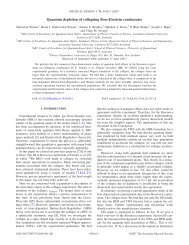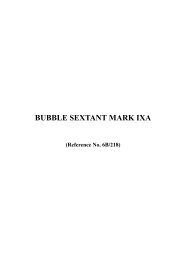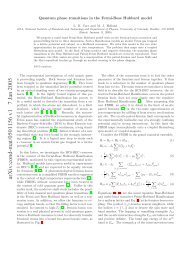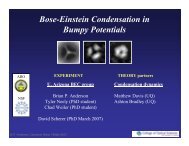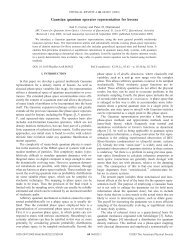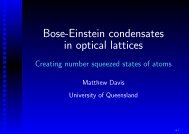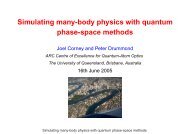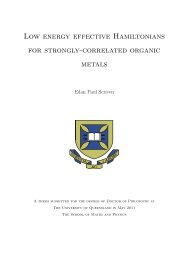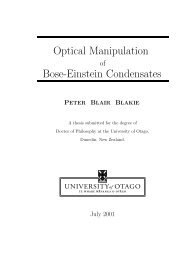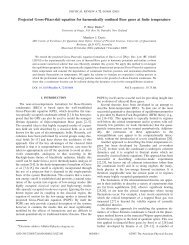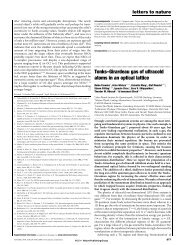Open Quantum Dynamics of Mesoscopic Bose-Einstein ... - Physics
Open Quantum Dynamics of Mesoscopic Bose-Einstein ... - Physics
Open Quantum Dynamics of Mesoscopic Bose-Einstein ... - Physics
You also want an ePaper? Increase the reach of your titles
YUMPU automatically turns print PDFs into web optimized ePapers that Google loves.
4. Continuously monitored <strong>Bose</strong> condensates: quasiprobability distributionsFigure 4.7: Conditional dynamics <strong>of</strong> 〈 〉Ĵ x c (continuous line) and 〈 Ĵ z (dashed line) when Θ=0〉cfor different measurement strengths. In (a), Γ=16and in (b), Γ = 1600. The time axis is scaledby t 0 =1/Ω.50 c(a)50(b) c0 50 100 150 200 c c00−500 50 100 150 200t/t 0−50t/t 0An alternative initial stateThus far, in dealing with the monitored <strong>Bose</strong> condensate, we have been starting with theequal-weight number state ∣ 〉j, 0x , or its rotated cousin ∣ j, 0 . But there are other initial〉ystates which generate the required symmetric spatial distribution <strong>of</strong> atoms. Starting withthe system in the atomic coherent state ∣ ∣j, −j 〉 gives the conditional dynamics shown inzFigs. 4.7 and 4.8. This state is the ground state <strong>of</strong> the Hamiltonian Ĥ2 when the atomiccollisions are very weak (Θ ≪ 1). Not only is it symmetric between the two wells, butit also contains no tunnelling-phase information, unlike the hidden phase in the numberstate ∣ j, 0 . The tunnelling oscillations take longer to develop with the Bloch state, as〉xthe phase must first be established. For a medium interaction strength (Fig. 4.7(a)),oscillations <strong>of</strong> a definite phase are established by t =40t 0 and these grow to be <strong>of</strong> a largeamplitude by t = 120t 0 . In a strong measurement (Fig. 4.7(b)), full oscillations appear att =35t 0 which persist, interrupted occasionally by jumps in the phase.Figure 4.8 shows the effects <strong>of</strong> the atomic collisions on the monitored system startingin this state. For weak collisions (Θ = 0.01), the dynamics appear unchanged (Fig. 4.8(a)):once again the measurement suppresses the collapses and revivals seen in the closed system.If we increase the collision strength (Figs. 4.8(b&c)), the period and amplitude decrease,just as they did for the semiclassical trajectories that started at (x, y, z) =(0, 1 2, 0). Theperiod in Fig. 4.8(c) for Θ = 2 is almost half the collisionless value, as it is in the semi-91



